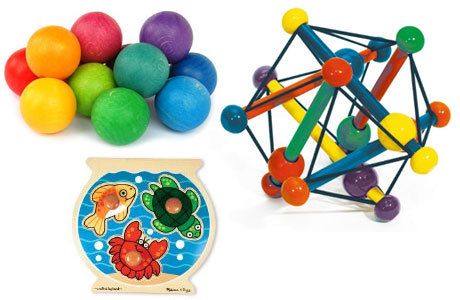
What about these?

Or even these?


Preparing the Infant/Toddler Environment: Modern Montessori Materials for 0 to 2 Years Old
Montessori materials have evolved over time. In fact, many of Dr. Montessori’s first materials were originally created by her mentor, Edouard Séguin, when he was working with children developmental disabilities. Montessori saw the value in Séguin’s materials and modified them for use with children in her schools.
.JPG)
Montessori was a scientist who employed the scientific method of observation, hypothesis, experimentation, and revision. She carefully observed the children in her care and, based on her findings, developed and modified materials according to the children’s developmental needs.
According to Angeline Lillard, a professor of psychology at the University of Virginia, there are two schools of thought about the Montessori method: the traditional approach and the modified Montessori approach (Lillard, 2008). Those who follow the traditional Montessori approach only use materials personally used and developed by Dr. Montessori herself. Those who adapt a modified Montessori approach carefully observe the children around them and, just like Dr. Montessori, they add materials that are beautiful, natural, and most importantly,developmentally appropriate.
If you do choose to bring in additional materials into your Montessori infant/toddler environment, it is important to remember that Dr. Montessori developed her materials to serve both a direct and indirect purpose. For example, the stacking rings in the first photo directly prepare the child to develop hand-eye coordination, as well as color recognition. Indirectly, the rings prepare the child to sort by graduated size, a mathematical and scientific skill.

Another matter to consider when selecting new materials is whether the material fulfills the infant’s need to develop movement and sensory awareness. Also, is it made of natural materials? Is it beautiful? Does it call the child to use it repeatedly? Most importantly, does it serve a real and true purpose?
Choosing to bring alternative or modified materials into your Montessori environment will be up to you and your school. However, whether teachers prefer a traditional or modified Montessori approach, they can all agree on the importance of preparing the infant/toddler environment with materials that are answer the children’s needs.
All Educational Toy Photos care of Amazon.com
As much as possible, NAMC’s web blog reflects the Montessori curriculum as provided in its teacher training programs. We realize and respect that Montessori schools are unique and may vary their schedules and offerings in accordance with the needs of their individual communities. We hope that our readers will find our articles useful and inspiring as a contribution to the global Montessori community.
© North American Montessori Center - originally posted in its entirety at Montessori Teacher Training on Friday, July 19, 2013.
© North American Montessori Center - originally posted in its entirety at Montessori Teacher Training on Friday, July 19, 2013.

I too would bring modern materials into our Toddler environment. I always would make sure that there was an educational reason why they were on the shelf. Not just "toys" to play with. Sometimes, sorting, eye/hand coordination, sequencing, etc. One needs to be able to explain why the work is on the shelf. :)
ReplyDeleteDr. Montessori did not have infant or toddler classes, at that time, children remained in home at such a young age. Therefore, she did not develop materials for infants and toddlers. While some things can be appropriately adapted, such as simplified dressing frames and practical life activities, others cannot. Introducing a smaller set of knobbed cylinders or the larger cubes from the pink tower to a toddler environment is not helpful. At that age, it is difficult to understand why blocks cannot be pushed over and many things can teach the lessons that a toddler would gain from the cylinders. There is a reverence that a 3 year old has for these materials, when presented in the 3-6 environment, with the correct presentation and all pieces present. That is lost when he has been using them in the toddler class. I have seen many of the above listed items in various Montessori toddler environments, and I have used many myself. Some are more beneficial in an infant environment, such as the Skwish and the wooden rattle. I have had a ball tracker in every class I have ever had, it is wonderful for many things including distracting a child who is sad to say goodbye to his parent. It also teaches cause/effect, visual tracking, problem solving etc. I do not care for that particular puzzle, while it is knobbed, I think that the design is too busy for my taste, others might disagree. We do have regular blocks and that exact hammer work.
ReplyDeleteI can see how the one or two year oldwould benefit from these objects shown in the image above (hammer, colourful blocks and balls may teach children different colours and shapes. As well as how the others may be helpful for eyeand hand coordination. But i fail to understand how this would help the younger children who are three months to a year old. Could someone help me understand how these objects would still be age appropriate beyond the fact that they may be able to pick them up and place them in their mouths just to have a feel of what they are?
ReplyDelete